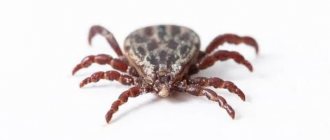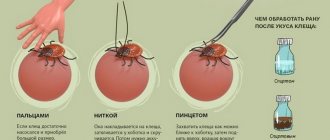Many people think that ticks can only bite a person or a dog, without posing a danger to the cat family. This is not true; according to statistics, cats suffer from tick bites and develop complications much less frequently, but the course of the disease, diagnosis and treatment are more difficult. Even domestic cats require special attention, since the parasite can enter the house through shoes or on human clothing.
Ticks are especially active from March to November; they can be found in grass or bushes, in city parks, and forests. Parasites pose a danger to walking animals, but even if the animal does not leave the house or apartment, the risk of finding a parasite in a cat is not so small.
What to do if your cat is bitten by a tick
If a cat is bitten by a tick, it is necessary to determine its type, of which there are more than 1000: dust ticks, ear ticks, scabies, etc. Ixodid ticks are considered the most dangerous for cats, as they are carriers of pathogens of many diseases.
It is necessary to examine the surface of the skin to determine the extent of its penetration. It is advisable if a specialist removes the parasite, since there is a risk of leaving part of the head under the skin. Also, when the insect moves strongly, the spread of infection increases.
Most often, bloodsuckers choose to bite the groin area, behind the hind legs, ears, stomach and armpit. An attached parasite is visible to the naked eye; immediately after detection, it is advisable to isolate the cat from children, take it to the veterinarian, or try to get rid of the insect yourself.
If a cat is bitten by a tick, then at this moment the animal does not experience pain or discomfort because upon penetration the parasite releases pain-relieving enzymes. Therefore, during the active months of parasite reproduction, you should regularly examine your cat; you can run a comb against the grain and feel the vulnerable spots.
How to remove a tick if it has not yet attached itself
When removing a tick, be sure to wear gloves; you can also put a plastic bag on your hand. The tick cannot be crushed; it must be placed in a bottle. Touching a bloodsucker in itself is not dangerous, but there is no guarantee that when caught, the tick will not be crushed, and the causative agents of dangerous infections will not end up on the human skin and mucous membranes.
Any tick that has not attached itself must be burned . You should not throw it in the trash or down the drain - this will not destroy it.
How to tell if a tick has bitten your pet
If the tick moved freely, there is a high probability that it chose a place to bite and did not have time to penetrate the skin. Signs of a tick bite do not have typical differences - the site of penetration will look like a small tubercle of swelling or inflammation with a small pinpoint wound from which bloody fluid may ooze, since the tick's saliva contains substances that prevent blood clotting. The cat may scratch the bite site.
A tick can dig in absolutely anywhere, but more often it is found in secluded places where the skin is thin, the capillaries are close and where it will be difficult to scratch it off with a paw. Therefore, bloodsuckers are most often found:
- in the armpit and groin areas;
- on the stomach;
- behind the ears;
- at the withers;
- on the front of the neck;
- in the area under the tail.
If the tick has burrowed in for a long time, then its head and front legs may already be in the thickness of the skin. The head of this arachnid is fixed very firmly. To the touch, a sucked tick is a soft elastic tubercle located where it was not there before.
You should be careful not to mistake your cat’s nipples for ticks; Cats also have rudimentary (weakly expressed) nipples.
Symptoms of a bite in cats
Symptoms of a tick bite in cats do not appear immediately after detection; the animal behaves calmly, has good appetite and sleep, and the cat does not feel pain, since the parasite uses pain-relieving enzymes during its introduction.
After it has been removed from the skin, it is necessary to monitor the condition of the pet. In case of infection and infection enters the bloodstream, the disease can begin to manifest itself only after a few weeks - the incubation period of infectious diseases.
Symptoms of a tick bite in a cat that should alert you:
- urine has turned pink;
- cough, heavy breathing;
- paleness of the nasal mucous membranes;
- vomiting, bowel dysfunction;
- signs of dehydration;
- sudden weight loss;
- loss of appetite or complete refusal;
- lethargy, lack of interest in the environment;
- heat.
If one or more symptoms occur, you should contact your veterinarian to preserve the health and life of your pet.
Localized demodicosis
Treatment at home involves the use of specialized shampoos to wash the coat and effectively cleanse the skin. This shampoo should contain chlorhexidine or benzoyl peroxide. After washing, deformed skin is freed from marks and crusts using an antiseptic solution or H2O2.
The treated skin is dried. Special medications, Stronghold or Advocate, are applied to the pet’s skin in the area of the shoulder blades 2 to 4 times a month. Sometimes veterinarians recommend using Amitraz or Butox 50 in strict accordance with the instructions for it.
Areas of the body that have been damaged by subcutaneous mites are additionally treated with Citeal solution, but only with the permission of a veterinarian. The use of the product is completed by thoroughly washing the skin and drying it. The frequency of similar procedures should be from 2 to 4 times a day. When the crusts disappear from the affected areas, they continue to be treated with one of the medications recommended by the veterinarian. As a rule, we are talking about a special ointment.
When getting rid of keratinized crusts, it is convenient to cover the damaged areas of the skin with special oil solutions. Sometimes experts recommend using medications in the form of sprays. To exclude the occurrence of complications, therapy should be associated with the use of drugs to enhance immunity. The pet needs to restore its vitality, so you need to monitor its diet. The cat is given non-carbonated mineral water to speed up recovery.
Consequences of a bite
Are ticks dangerous for cats? The parasite's bite itself does not threaten the health of the pet; the danger lies in the pathogens that can get from it to the animal through the bite. The Ixodid tick can cause the development of diseases such as piroplasmosis, hemorrhagic fever, typhus and encephalitis, and borreliosis.
If treatment is not started on time, the infection can affect many body systems and internal organs of your furry friend.
If a cat is bitten by a tick, the consequences, symptoms and treatment depend on the type of infection. Some diseases only affect the cat’s immune system, it becomes lethargic and apathetic, but treatment in this case is 95% effective. Other diseases may not respond to treatment and lead to the death of the pet.
Preventive actions
Even after suffering from the disease, the body does not develop immunity to re-infection with subcutaneous mites. For this reason, it is important to carry out preventive measures in a timely manner. Experts give their recommendations on this matter.
They recommend:
- to exclude as much as possible possible contacts between the pet and other animals that may have health problems;
- regularly treat the cat’s skin using anti-inflammatory drugs;
- Monitor a balanced diet, vaccinations, and the amount of minerals and vitamins consumed in order to naturally maintain the cat’s high immunity.
Attentive attitude towards the animal becomes the key to its excellent health. A cat in excellent health is much less susceptible to subcutaneous mites, so she is safe.
What to do at home if you are bitten
If the bloodsucker has not burrowed into the pet’s skin and it is found on the fur or in the place where the cat sleeps, then it is necessary to inspect the skin. Using a comb, you need to comb the animal against the fur, push it apart with your hands and inspect the skin. Favorite places for parasites to invade are the armpits, hind legs, stomach and groin. If a bite is detected, it is necessary to treat the wound or take it to a veterinary hospital; you should monitor the cat’s health for several weeks; if deterioration occurs, you should consult a doctor.
You can get rid of the parasite as follows:
- Wear gloves on your hands, and upon completion of all manipulations, carefully perform hygiene.
- To prevent the infection from spreading faster, do not lubricate the area around the tick with oil.
- You should not pull the parasite, this will lead to further penetration of the insect's head and the spread of infection.
- The tick must be removed completely without damaging it.
- You can remove the insect using thread or tweezers. You should grab the body of the parasite and pull it out gently and without sudden movements.
- If, however, part of the tick’s head remains in the skin, there is no need to worry too much, since the cat’s body can independently reject the remaining body. This often leads to the development of a small abscess, which can be prevented by contacting a veterinarian.
Treatment is prescribed only by a veterinarian based on the test results and existing symptoms; usually, antibiotic therapy cannot be avoided. You are allowed to treat the bite site yourself at home using antiseptic drugs, with the exception of iodine and brilliant green.
Prevention of diseases transmitted by ticks
Unfortunately, there are no reliable vaccines to protect cats from tick-borne infections. Therefore, the only way to take care of your pet’s health is to strictly follow the requirements for infection prevention.
After each walk in the fresh air, carefully inspect the cat and comb it, paying special attention to the favorite places for ticks to attach.
To prevent tick attacks, special protective equipment should be used. Thus, drops with a repellent effect “Four with a tail” contain a mixture of essential oils that repel ticks and insects. “Bars” drops have an insectoacaricidal effect that destroys parasites, and “Bars” collars can protect a cat from ticks for up to 4 months.
Ixodid ticks in cats
A tick bite that carries piroplasmosis or encephalitis does not pose a danger to a cat, but other more dangerous diseases can develop, such as theileriosis, tularemia and hemobartonellosis. Ixodid ticks are one of the most famous types of parasites, common in many climatic zones.
Symptoms and consequences have different characteristics - it all depends on the type of pathogen. Each disease has a distinctive clinical picture and incubation period:
- Hemobartonellosis. This infectious disease causes anemia only in cats; the disease is not dangerous for humans and dogs. The infection, spreading throughout the body, settles in the lymph nodes, bone marrow, liver and spleen. The incubation period ranges from several days to three weeks. The manifestation of symptoms depends on the animal’s immune defense; with weak immunity, the disease becomes severe. The disease manifests itself in decreased appetite, rapid heartbeat, lethargy and fading of the cat, the skin is pale or yellow, and the temperature is elevated. Only an urgent visit to the veterinarian can save the life of a pet.
- Tularemia. The pathogen enters the lymph nodes through the cat’s blood, developing a purulent inflammatory process. After some time, the lesions are opened, which leads to even greater blood infection. The disease affects the spleen, liver and lungs. Tularemia manifests itself in the form of lethargy of the animal, the skin becomes yellowish, small ulcerations form on the mucous surfaces, the lymph nodes in the neck are enlarged, the animal experiences malaise and fever. If treatment is not started in time, the cat dies in a matter of time, one of the causes of death is necrosis of the tissues of the spleen, lungs and liver. This disease is dangerous to humans and is transmitted through contact.
- Theileriosis. The infection, entering the animal's blood, multiplies in the spleen, lungs, liver and lymph nodes, causing severe damage. The first symptoms appear 1–3 weeks after the tick bite: the cat becomes lethargic, the temperature rises, the skin is yellow, the cat looks thin and apathetic, and the appetite disappears. Upon examination, the veterinarian notes an increase in internal organs. The disease is difficult for cats to tolerate, and only timely treatment can save the animal’s life.
To prevent such consequences after an ixodid tick bite, it is necessary to carry out prevention, constant examination of the animal and timely treatment.
Diseases of cats caused by subcutaneous mites
Notoedrosis (pruritic scabies) – Notoedrosis is a chronic invasive disease of cats, clinically accompanied by dermatitis in the scalp, itching, scratching and hair loss.
Etiology. The causative agent of Notoedrosis in cats is the sarcoptic mite Notoedrosis cati. Its morphology is somewhat similar to mites of the genus Sarcoptes. The body of sexually mature ticks is round in shape and dirty gray in color. It has a body length of 0.14-0.45 mm. The proboscis is horseshoe-shaped, the anus is located on the dorsal side, and in females there is also a copulatory opening. The legs of the tick are short, thick, and cone-shaped. Male ticks have bell-shaped suckers on conical rods (ambulacras) on the 4th pair of legs. In females, the 3rd and 4th pair of legs do not have bell-shaped suckers. Itches parasitize and multiply in passages that they gnaw in the deep parts of the stratum corneum of the skin, directly bordering the malpighian layer.
Developmental biology, epizootological data, pathogenesis, clinical picture, diagnosis, differential diagnosis, treatment and prevention are described in our article - Notoedrosis (pruritic scabies) in cats.
Feline demodicosis is a chronic parasitic skin disease in cats caused by the microscopic worm-like mite Demodex cati.
Etiology. The causative agent of demodicosis, being itself an endoparasite, is localized in the hair follicles and sebaceous glands. It is half a millimeter long and has a transparent body with poorly defined boundaries between the cephalothorax and abdomen. It has short legs with hooks at the ends. The oral apparatus is equipped with a gnawing type proboscis. When a cat is infected with demodicosis, the parasite first penetrates the skin. At the site where the tick gnaws through the skin, it leaves a pronounced concentric spot. Having penetrated the skin, mites begin to feed on skin cells, and the mites multiply intensively. For more information about demodicosis in cats, see our article – Demodicosis in cats.
Otodectosis or ear scabies is a chronic invasive disease of cats caused by parasitic otodectosis mites on the inner surface of the ears and in the external auditory canal.
For more information about the disease, see our article – Otodectosis in cats.
Can a tick fall off on its own from a cat?
Ticks and cats are a hot topic for the hot season, since it is in the summer that animals most often suffer from parasite bites. Having discovered a parasite attached to a pet, many people have a question: can the tick fall off on its own?
It is better not to wait until it detaches itself; it is necessary to remove the insect as soon as possible, since the longer the parasite is under the skin, the more infection will enter the blood. In some cases, when the tick is completely saturated with blood, it is able to fall off on its own.
Where do ticks spend the winter?
During the winter, ticks hibernate. Their comfortable time - warm and humid - gives way to cold weather. They choose deciduous forests, where they can burrow into the depths of fallen leaves until spring. However, spring for ticks can come much earlier than the calendar year.
As soon as the temperature rises to 0 ℃, the parasite awakens and goes in search of food. Therefore, if in your region the temperature does not drop below 0 ℃ and the snow does not linger on the ground, you cannot lose vigilance all year round!
The same is true if you and your pet walk near heating mains. There, ticks don’t experience winter at all, because it’s warm and damp all year round.
Be careful in winter! And when the weather warms up, don’t forget about prevention.
Can a cat die from a tick bite?
Are ticks dangerous for cats? The parasite itself does not pose a danger to the animal if it is not the causative agent of any disease.
Can a cat die from a tick bite? With timely treatment and treatment, the animal’s health is restored without complications. If urgent measures are not taken, the animal’s body weakens in a matter of time, exhaustion and disruption of the functioning of internal organs are observed, which leads to serious consequences, including death.
How does infection occur?
Once on the cat's body, the tick begins to look for the warmest place. Increased temperature in areas such as the armpits, ears, folds of the neck, and abdomen means that the blood vessels are located closest to the surface, and the parasite can begin to feed without any extra effort.
Particularly insidious is the painlessness of a tick bite. At the same time that the parasite bites through the skin, it injects an anesthetic substance into it, which does not allow the cat to feel the bite and, accordingly, it does not cause any concern.
Not every tick bite causes illness in a cat. To do this, it is necessary that the parasite itself be a carrier of one or another pathogen and transmit it along with saliva into the bloodstream of the animal on which it parasitizes.
Are ticks on a cat dangerous for humans?
If it has already been saturated with cat blood, then it poses no danger to the human body. It is worth remembering that the parasite cannot infect a cat with encephalitis, while this disease is very dangerous for humans.
Having discovered a tick on an animal, it is possible that there may be several such parasites on the pet, in which case there is a risk that the insect will move onto a person’s skin and bite him. Therefore, it is important to examine your pet for parasites while wearing protective gloves.
Prevention
Preventing ticks from infesting cats by preventing contact with their relatives is almost impossible. The only way out is to prevent tick attacks on cats by using flea collars, drops and water-soluble emulsions.
If there are unfavorable areas for ticks in your area, they should be avoided. Before letting your cat into your apartment, you need to thoroughly comb out the fur with a fine comb and inspect the belly, paws, chest and ears for ticks.
Given that mites have the ability to survive for some time outside the cat's body, owners must protect their animals from re-infestation.
It is better to burn low-value items in the apartment, treat the floors with an acaricidal spray and wash them thoroughly.
Regular deworming, vaccination, disinfestation, and adequate feeding will provide the cat with strong immunity, which will not allow ticks that have fallen on the cat to actively reproduce.











